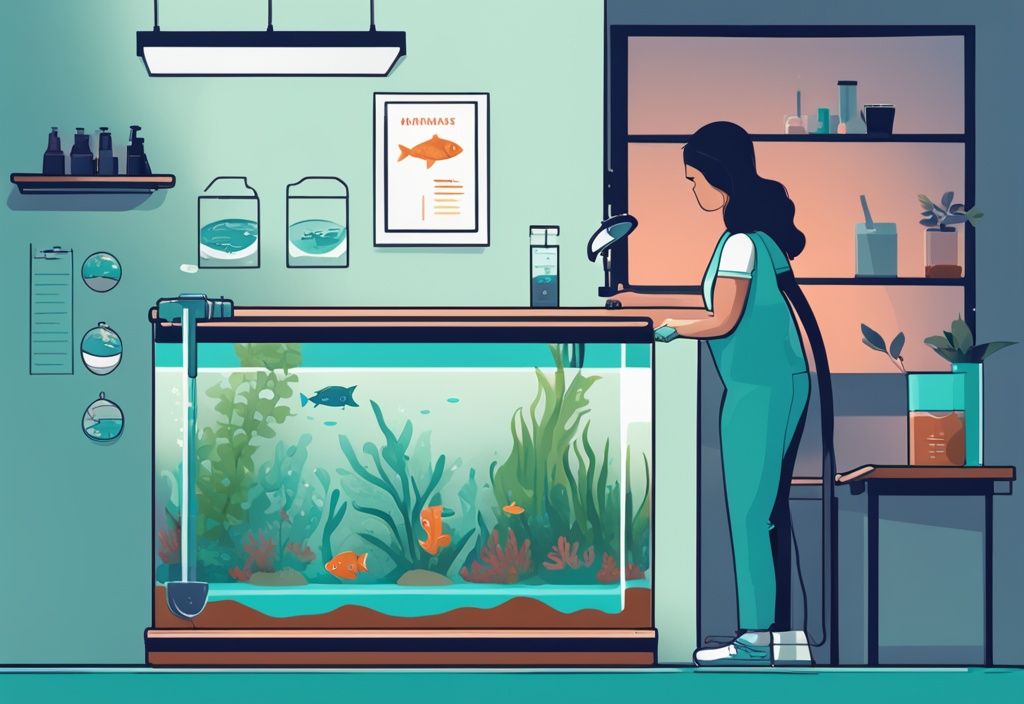Did you know that an unseen enemy is threatening the health of your finned friends? I’m talking about nitrates, the silent killers in your aquarium. Being a marine biologist for more than two decades, I’ve witnessed how high nitrate levels can unknowingly wreak havoc on tank ecosystems, causing stress and health complications in fish.
In this guide, you’re not only going to learn about the negative impacts of nitrates, but we’ll tackle how to lower nitrates in your fish tank effectively. We’ll dive into simple yet actionable steps, from regular maintenance to advanced filtering techniques, meaning you’ll be well equipped to create a balanced, healthier environment for your aquatic pets.
Before you know it, you’ll have mastered the art of nitrate management in aquariums, and your fish will thank you! Let’s swim into it together, shall we?
Understanding Nitrates in Your Tank
Nitrates are a significant concern in aquarium care. This section will delve into why high nitrate levels can be hazardous and how to recognize symptoms of nitrate poisoning in your fish.
Why High Nitrate Levels Are Dangerous
High nitrate levels in a fish tank pose several health risks to your aquatic friends, often leading to nitrate poisoning or old tank syndrome. This issue usually stems from neglected maintenance and infrequent water changes, allowing nitrates to build up over time.
Picture this: when nitrates concentrate in the tank water, they impair your fish’s growth, weaken their immune systems, and, if unaddressed, can be fatal. It’s crucial to recognize that different fish species have varying nitrate tolerances. Typically, freshwater fish can handle slightly higher levels than their saltwater counterparts.
For a safe environment, aim to keep nitrate levels below 20 parts per million (ppm). Although levels up to 50 ppm are relatively safe for most fish, lower levels are always better for their overall health and well-being. Ensuring regular water changes and proper tank maintenance is the key to preventing harmful nitrate accumulation.
Recognizing the Symptoms of Nitrate Poisoning
Early detection of nitrate poisoning is vital for the health of your fish. Symptoms often include lethargy and a noticeable lack of appetite. You might also see changes in their coloration, an early indicator that something is amiss.
In more severe cases, fish exhibit rapid gill movement or gasp for air at the water’s surface, struggling to breathe due to impaired oxygen absorption. Prolonged exposure to high nitrates can lead to stunted growth rates, making them more susceptible to diseases due to a weakened immune system.
Imagine one of your fish displaying these symptoms—it’s a clear call to action. Prompt measures to lower nitrates in your fish tank can prevent long-term damage, ensuring a healthy environment for your beloved aquatic pets. Regular monitoring and maintenance are your best allies in this endeavor.
Practical Methods to Reduce Nitrates
Regular Partial Water Changes: How and When to Do It
To understand how to lower nitrates in your fish tank effectively, incorporating regular partial water changes into your routine is crucial. Aim to replace 20% to 50% of your tank water consistently. The ideal frequency for these changes depends on several factors, including the tank’s maintenance schedule, biofiltration efficiency, the specific types of fish, and the filtration media in use.
For optimal nitrate reduction, try performing several small, staggered water changes. Start by reducing the water to 20%, refilling it up to 40%, and repeating this cycle until you achieve the desired nitrate level. Additionally, consider introducing some of the best tank cleaning fish to help maintain a clean and balanced environment. It’s essential to use water treated through reverse osmosis (RO) rather than tap water, as RO water helps prevent the introduction of additional nitrates into the tank.
Controlling Your Fish Feed and Population
Regulating the amount and frequency of fish feeding is another effective method for lowering nitrates in your fish tank. Overfeeding can lead to excess food waste, decomposing and contributing to rising nitrate levels. Feed your fish only the amount they can consume within a few minutes to ensure minimal waste.
Maintaining a realistic stocking density is also pivotal. An overcrowded tank can quickly lead to nitrate buildup due to increased waste. Regularly vacuuming the gravel helps remove uneaten food and other waste products that settle at the bottom, which can lead to nitrate accumulation if left unchecked.
This comprehensive approach—paired with attentive care and consistent maintenance—will significantly aid in keeping nitrate levels low, ensuring a healthier, thriving aquatic environment for your fish.
Using Nitrate-Absorbing Lives
Introducing Nitrate-Reducing Aquatic Plants: Freshwater and Saltwater Options
To naturally lower nitrates in your fish tank, incorporating aquatic plants is an effective strategy. These plants utilize nitrates as a nutrient, helping to keep nitrate levels in check while enhancing tank aesthetics.
For freshwater tanks, consider adding plants such as duckweed, frogbit, moss balls, water sprite, and water wisteria. These plants are known for their rapid growth and high nitrate consumption rates. Regular maintenance, including trimming and removing excess plant growth, ensures continued nitrate absorption and prevents overgrowth, which can block light and reduce oxygen levels.
In saltwater aquariums, options like mangroves, chaeto (Chaetomorpha algae), red gracilaria algae, and mermaid’s fan algae are excellent for nitrate reduction. These marine plants not only help to absorb nitrates but also offer hiding spots and enhance the overall ecosystem. As with freshwater plants, it’s crucial to maintain them properly by promptly removing dead or decaying parts to keep the tank’s environment healthy.
Supporting Anaerobic Bacteria Growth in Your Tank
Fostering anaerobic bacteria is another pivotal method to lower nitrates in your fish tank. These bacteria convert nitrates into harmless nitrogen gas, which escapes from the water. Creating suitable low-oxygen environments is key to promoting anaerobic bacterial growth.
Using deep sand beds within your aquarium is an effective approach. Aim for 3-6 inches of fine sand to provide the necessary low-oxygen conditions. Anaerobic bacteria thrive in these deep layers, breaking down nitrates efficiently.

Incorporating live rocks with porous structures can further enhance anoxic conditions needed for anaerobic bacteria. These rocks offer deep crevices where bacteria can colonize and perform denitrification. If you’re dealing with tiny white worms in your aquarium, understanding the role of these bacteria can be crucial to maintaining a healthy tank. Read more about these aquarium inhabitants and how they interact with the ecosystem. This method is particularly effective in saltwater tanks but can also be applied in freshwater setups with appropriate modifications.
Utilizing denitrators equipped with specialized bio-filtration media is another robust solution. These devices are designed to provide the deep, oxygen-poor environments that anaerobic bacteria require. When combined with regular tank maintenance and proper feeding habits, these methods significantly contribute to managing nitrate levels, ensuring a healthier tank environment for your fish.
Technological Solutions for Nitrate Reduction
When managing a fish tank, technological aids can be instrumental in maintaining optimal water quality. Here’s a closer look at two effective tools for reducing nitrate levels:
Utilizing Protein Skimmers to Lower Nitrate Levels
Protein skimmers are an effective solution on how to lower nitrates in fish tank environments, especially in saltwater setups. These devices work by removing organic compounds such as proteins and amino acids from the water before they can break down into ammonia and nitrates.
Picture the skimmer like a magnet for debris. It generates fine bubbles that attract these compounds, effectively skimming them off the water’s surface into a collection cup. This preemptive removal is crucial for maintaining lower nitrate levels.
Traditionally, protein skimmers were more common in saltwater tanks. However, advancements have made some models suitable for freshwater aquariums as well. Installing a protein skimmer can significantly reduce the overall nutrient load, alleviating stress on your filtration system, and promoting a healthier tank environment.
Aquarium Filters with Biological Media: The Benefit for Your Tank
Using aquarium filters equipped with biological filter media is another proven method on how to lower nitrates in fish tank setups. Biological media, such as bio balls, ceramic rings, or sponges, provide a large surface area for the colonization of beneficial bacteria.
These bacteria play an essential role in the nitrogen cycle. They break down harmful substances like ammonia and nitrites into less harmful nitrates.
Over time, with a well-maintained biological filter, the microbial community can even convert some nitrates into nitrogen gas, which is harmless.
However, it’s vital to regularly maintain and clean your filters to ensure they function optimally. A clogged filter can impede water flow and reduce the efficiency of the biological media, leading to higher nitrate levels.
By integrating a robust biological filtration system, you can maintain a healthier, more stable environment for your aquatic life.
Adjusting Your Tank Parameters
The Role of Proper pH Levels in Nitrate Control
Maintaining proper pH levels is a fundamental aspect of how to lower nitrates in fish tanks, directly influencing the overall health of the aquatic environment. Nitrate accumulation can result in lowered pH levels, causing distress to fish and disrupting the nitrogen cycle. It’s essential to ensure that the pH remains stable, as drastic fluctuations can lead to pH shock, further stressing the fish.
Gradually adjusting pH levels is a key practice. To increase pH, you can incorporate baking soda in measured amounts. Always consider the tank’s volume to avoid rapid changes. Conversely, if you need to lower pH, utilizing commercial pH adjusters specifically designed for aquariums is recommended. Regular monitoring and slight modifications facilitate a balanced and supportive environment for both fish and the beneficial bacteria essential for effective nitrate reduction.
Creating the Right Environment to Lower Nitrates
To create an optimal environment for lowering nitrates in a fish tank, natural cycling is crucial. Allow the tank to establish its own ecosystem without the frequent introduction of external bacteria. Over time, beneficial bacteria populations will naturally develop, effectively managing nitrate levels.
Rather than continuously adding new bacteria, it’s more beneficial to promote a stable and consistent habitat that supports natural anaerobic bacterial growth. Installing a sump can significantly aid in this process. A sump provides a space where anaerobic conditions can thrive, promoting the activity of denitrifying bacteria. These bacteria convert harmful nitrates into harmless nitrogen gas, thus lowering nitrate levels effectively.
By stabilizing your tank’s environment and supporting the natural biological processes, you can achieve a sustained and efficient decrease in nitrate levels, ensuring a healthier ecosystem for your aquatic inhabitants.

Proactive Measures to Keep Nitrates Low
Ensuring low nitrate levels in your fish tank is critical for maintaining a healthy aquatic environment.
Preventing Nitrate Build-Up: Best Practices
One of the most effective ways to keep nitrates in check is to prevent their build-up from the outset. An overstocked tank often leads to excessive waste, which then translates to higher nitrate levels. Always adhere to recommended stocking densities based on your tank size and the specific species you are keeping. Additionally, incorporating house plants in your aquarium can help reduce nitrate levels and improve water quality.
Overfeeding is another major culprit in nitrate accumulation. Feed your fish only what they can consume within a few minutes to minimize leftover food. Excess food decomposes and adds to the nitrate burden. Regular maintenance is also essential for reducing nitrates. Clean filters frequently, vacuum gravel to remove uneaten food and waste, and ensure efficient biofiltration.
Monitoring nitrate levels regularly with test kits helps track the effectiveness of your strategies. Weekly testing gives you a clear picture of your tank’s nitrate levels, enabling timely interventions if readings are higher than desired.
Tracking Your Progress: How to Monitor Nitrate Levels
Keeping a close eye on nitrate levels is crucial. Reliable nitrate testing kits are invaluable tools. Conduct tests weekly to stay informed about the nitrate concentrations in your fish tank. Regular monitoring helps you identify trends, assess the effectiveness of your reduction strategies, and make necessary adjustments.
Recording nitrate readings over time is beneficial. Note the readings in a logbook or spreadsheet to diagnose patterns and pinpoint any factors contributing to nitrate spikes. This documentation will guide your maintenance routines, ensuring consistent and effective nitrate control. By maintaining an overview of nitrate levels, you can prevent build-up and sustain a healthy, thriving aquatic ecosystem.
Adopting these proactive strategies and regular monitoring practices ensures you effectively manage nitrate levels, thus promoting a balanced and vibrant environment for your aquatic life.
FAQs
How often should I check nitrate levels in my tank?
Nitrate levels act as a silent indicator of your tank’s health.
It’s best to check them weekly to catch any fluctuations early on. Symptoms of nitrate stress in fish, such as lethargy or discolored gills, signal that more frequent testing might be required. Regular monitoring helps maintain a balanced environment, ensuring your aquatic friends thrive.
What are the signs of nitrate stress in my fish?
It can be distressing to see your fish showing signs of nitrate stress.
Look out for lethargy, a noticeable lack of appetite, or discolored and inflamed gills. Rapid gill movement and gasping at the water’s surface are also red flags. Early detection of these symptoms is crucial in preventing long-term health issues in your fish and maintaining a vibrant tank.
What tools can I use for nitrate reduction?
Reducing nitrates in a fish tank is vital for a healthy aquatic environment. Several tools can help:
- Protein Skimmers: These remove organic compounds before they decompose into nitrates.
- Biological Media Filters: Promote the growth of beneficial bacteria that break down nitrates.
- Deep Sand Beds and Live Rocks: Provide anaerobic conditions for denitrification.
- Denitrators: Specialized filters that specifically target nitrate reduction.
- Nitrate-Absorbing Plants: Incorporate aquatic plants like duckweed or water sprite to naturally lower nitrate levels.

Implementing these tools can effectively manage and reduce nitrate levels, promoting a balanced and healthy aquarium.
How quickly should I reduce nitrates to avoid fish stress?
Nitrate reduction needs to be handled delicately to avoid shocking your fish.
While a rapid decrease in nitrate levels can be safer than prolonged high exposure, it’s best to spread this reduction over several days. Gradual water changes can help, ensuring your fish adapt without added stress. It’s all about finding that sweet spot for a stress-free environment.
Are nitrate-removing chemicals safe for my fish?
Nitrate-removing chemicals are an option, but they come with caveats.
While effective, these chemicals should be used cautiously due to potential side effects on both fish and plants. Whenever possible, natural methods—like increased plant life or improved filtration—are safer and more sustainable ways to maintain low nitrate levels. Aim for balance and gradual changes for the healthiest tank environment.
Concluding Thoughts on Nitrate Reduction in Fish Tanks
Managing nitrate levels in a fish tank requires a multifaceted approach, as there isn’t a one-size-fits-all solution. The key to understanding how to lower nitrates in fish tanks lies in integrating several strategies tailored to the specific needs of your aquatic environment.
Regular maintenance stands out as a cornerstone practice; this ensures that excess nitrates don’t have the chance to build up to harmful levels. Regular partial water changes—replacing 20% to 50% of the tank water—help keep nitrates in check. The frequency of these changes largely depends on factors such as biofiltration efficiency, the type of fish, and the filtration media in use.
Proper feeding habits are another crucial component. Overfeeding your fish can dramatically increase waste products in the tank, leading to higher nitrate levels. Feed your fish only what they can consume within a few minutes, and maintain a low stocking density to help manage waste production. Regularly vacuuming the gravel to remove uneaten food and other debris also contributes to nitrate control.
Biological filters play a significant role in managing nitrates. Using filters equipped with biological media that harbor beneficial bacteria can aid in the process of converting nitrates into less harmful substances. Meanwhile, nitrate-absorbing plants are beneficial for natural nitrate reduction. Introducing aquatic plants that utilize nitrates as a fertilizer will help you maintain lower nitrate levels.
Consider freshwater plants like duckweed and water wisteria, or saltwater options like chaeto and red gracilaria algae. Regular trimming and removal of excess plant growth ensure that they remain efficient in nitrate absorption.
Consistent monitoring of nitrate levels is paramount. Using reliable nitrate testing kits on a weekly basis allows you to track nitrate levels and adjust your maintenance routines accordingly.
Recording these readings can help to identify trends and evaluate the impact of your interventions, enabling proactive adjustments to prevent nitrate build-up.
Balancing various methods and continuously adjusting strategies based on your tank’s specific conditions will ultimately lead to successful nitrate management. By integrating regular maintenance, proper feeding habits, efficient biological filtration, and the use of nitrate-absorbing plants, you can maintain a healthy, thriving aquatic environment.
Understanding how to lower nitrates in fish tanks and implementing these comprehensive measures ensures your fish live in a safe and stable habitat.
